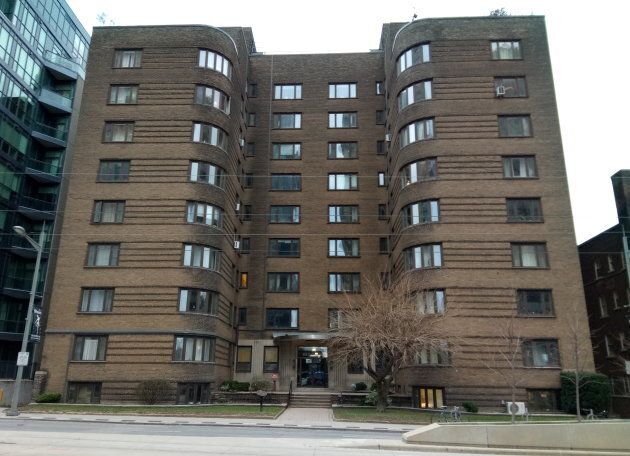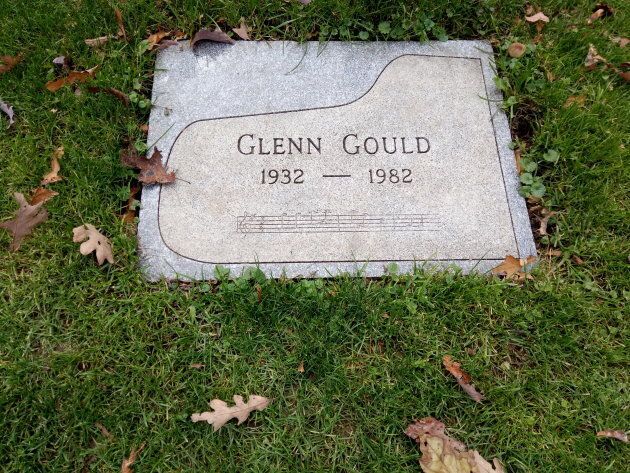I met a man called George at a bar opposite the Davisville metro station, six days after I arrived in Toronto. I didn't ask for his last name, because conversations with strangers in bars tend to begin and end with the firm conviction that we are but ships passing in the night. We chatted cursorily for a few minutes until he asked what I had spent my first week in Canada doing.
"Í paid my respects to Glenn Gould," I told him, and his eyes lit up.

George, as it turned out, couldn't wrap his head around the fact that someone who wasn't Canadian would know who Gould was, let alone know where he was buried. So, I told him of my joy at finding myself in an apartment overlooking Mount Pleasant Cemetery in Toronto, where Canada's most famous pianist now lies in eternal rest. It was a mere 300 feet from where we sat, I pointed out, which prompted him to ask the bartender for pen and paper so he could make a note of it.
"My parents are buried there," he told me. "But I had no idea Gould was, too."
This was my first impression of what the late pianist continues to mean to Canadians. I knew he had been an iconic figure in his time, but decades had passed since his untimely death at age 50. I had no idea who Gould was while growing up on the other side of the planet, in Bombay, India. There was almost no Western classical music to be heard there, unless one could afford piano lessons or travelled abroad and knew what concert halls were like. Bombay had an opera house, but it had closed long before I was born.
It is only after the arrival of the internet, coupled with the arrival of money in my bank account by way of a decent salary, that I found myself in possession of Gould's 1955 recording of "The Goldberg Variations." It was an album that made him a star almost overnight on both sides of the Atlantic, although news of his celebrity didn't make it to my corner of the world.
Gould passed away when I was six, while the life-giving repository of information that is Wikipedia was launched only when I turned 25. There was no press coverage of his achievements in India, which meant that my first exposure to his music wasn't coloured by anything extraneous to the act of listening itself. What that recording did, however, was set me on a path of discovery that I continue to walk to this day. I eventually found out that he had done the same thing for millions of others over the course of his eventful life, changing the way we listened to Bach forever, and introducing many of us to a world we had no idea even existed.

Why did Gould move me the way he did? It was a question I asked myself repeatedly, as I began reading more about him and watching poor quality video clips of his performances on YouTube. It wasn't as if there weren't better piano players, because a lot of them had been recognized as great interpreters of Bach's music for years. It wasn't as if I related to him in any particular way, either, considering I had no idea about Toronto, what his childhood and early schooling was like, or what it meant to be a performer in his part of the world.
The more I thought about it, the harder it was for me to come up with a coherent explanation for why this music moved me. In the end, I had to settle for the fact that it just did, for reasons known neither to me nor, in all possibility, to Gould himself. He did try answering that question himself, apparently, on a number of occasions, trying to put one of his talented fingers on precisely what made audiences gravitate to his often controversial interpretations of music written centuries ago. If he couldn't come up with a satisfying response, I assumed it made no sense for me to keep trying.
In short, I found a hero casually ignored by the city he called home.
One of the nicest things about arriving in Toronto was, at least for me, the comforting shadow of Glenn Gould. I assumed there would be a museum I could spend an afternoon in, but there wasn't. I walked past the apartment he once lived in, on St. Clair Avenue, but found no plaque informing casual passersby of the national icon who once resided there. It wasn't a particularly welcoming place either, so I stopped by for a few minutes before moving on. I found a park named after him, but no mention of his achievements or why that particular piece of land had been associated with him. I found out that memorabilia about him was now held at the National Library of Canada in Ottawa. In short, I found a hero casually ignored by the city he called home.
I continued to read about Gould as I walked across the city over the next couple of weeks, huddled against a cold I had never experienced before. I read about the relentless attacks by music critics on his mannerisms, the cynical reviews of his radio broadcasts, and the snide remarks that accompanied his documentary for television titled Glenn Gould's Toronto. It was the equivalent of realizing why Mozart had been hounded out of Salzburg, a city that today, ironically enough, would struggle to attract tourists without capitalizing on his name and visage at every corner.
More blogs from HuffPost Canada:
Fans of an artist often obsess over the minutiae, which is what I caught myself doing every now and again. I lay awake for a couple of nights, looking up at a foreign sky, thinking about two golden phonograph records on board the Voyager spacecraft. Launched in 1977 and expected to pass a constellation called Camelopardalis in 40,000 years, the records were meant to be a time capsule, introducing intelligent extraterrestrial life forms to the best that our planet had to offer. I thought about the presence of Gould on both those records, in the form of a four-minute, 48-second performance of "Prelude and Fugue in C, No.1" taken from Book 2 of Bach's "The Well-Tempered Clavier." What would alien life forms make of these curious arrangements that combined mathematics and musicality, brought to life by an unassuming, hypochondriac man who never wanted to play for an adoring public?

Two days after stepping foot into Toronto, I found myself at Mount Pleasant Cemetery. One website had helpfully mentioned that Gould lay buried in Section 38, while another said it was one of the most visited graves in Canada, with admirers from all over the globe coming to pay their respects. It took me little over a half hour to locate. There were no markers, which compelled me to crisscross the section diagonally a few times until I found a memorial plaque.
There was no one around, so I stood before the simple stone marker set into the ground, engraved with the opening bars of "The Goldberg Variations." I tried one final time to understand why this music played a half-century ago still caused tears to spring to my eyes, and why it continued to echo in my head. There were still no reasons forthcoming, so I simply stayed for a while and listened.
Also on HuffPost: